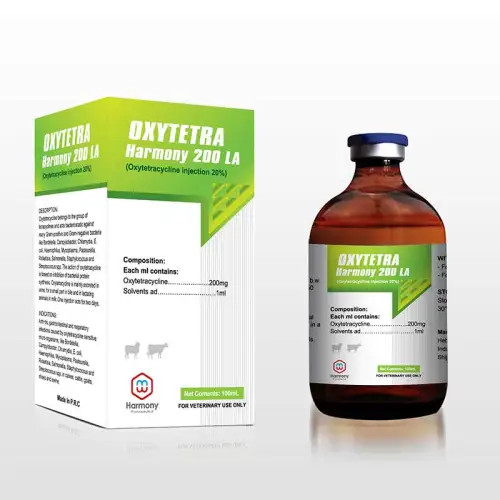Antibacterial Products
Product Description
About Oxytetracycline Injection
Product Description
Composition:
Each ml contains:
Oxytetracycline………………….……….200mg
Solvents ad……………………………………1ml
Description:
Oxytetracycline belongs to the group of tetracyclines and acts bacteriostatic against many Gram-positive and Gram-negative bacteria like Bordetella, Campylobacter, Chlamydia, E. coli, Haemophilus, Mycoplasma, Pasteurella, Rickettsia, Salmonella, Staphylococcus and Streptococcus spp. The action of oxytetracycline is based on inhibition of bacterial protein synthesis. Oxytetracycline is mainly excreted in urine, for a small part in bile and in lactating animals in milk. One injection acts for two days.
Indications:
Arthritis, gastrointestinal and respiratory infections caused by oxytetracycline sensitive micro-organisms, like Bordetella, Campylobacter, Chlamydia, E. coli, Haemophilus, Mycoplasma, Pasteurella, Rickettsia, Salmonella, Staphylococcus and Streptococcus spp. in calves, cattle, goats, sheep and swine.
Dosage & Administration:
Administrate by Intramuscular Route according to the following:
Cattle, Calves and Horse: 3-5 ml/100 kg b.w.
Sheep, Goats and Swine: 2-3ml per 50 kg b.w.
Side Effects:
After intramuscular administration local reactions can occur, which disappear in a few days.
Discoloration of teeth in young animals.
Withdrawal Period:
- For meat: 28 days
- For milk: 7 days
Storage:
Store at room temperature (not exceeding 30℃), protect from light.
What is Oxytetracycline injection?
Oxytetracycline injection is a sterile, ready-to-use solution for the administration of the broad-spectrum antibiotic oxytetracycline by injection.
oxytetracycline injection does not require refrigeration; however, it is recommended to store it at 59° to 86°F (15° to 30°C). In the presence of body fluids, serum or exudate, the antibiotic activity of oxytetracycline will not be significantly reduced.
Precaution of Oxytetracycline injection:
► When given to cattle, muscle discoloration during dressing changes may require trimming the injection site and surrounding tissues. Stop treatment at least 28 days before slaughtering cattle and pigs. Milk drawn from animals during treatment and within 96 hours after the last treatment shall not be used as food. Rapid intravenous administration may cause animal paralysis. Oxytetracycline should be administered slowly intravenously for at least 5 minutes.
► Exceeding the highest recommended dose level per pound of body weight per day, exceeding the recommended number of treatments, and/or intramuscular or subcutaneous injection of more than 10 mL per injection site for adult beef and dairy cows, and 5 mL per injection intramuscularly for infection in adult pigs Site, there may be antibiotic residues after the withdrawal period.
Adverse reactions of Oxytetracycline injection:
Reports of adverse reactions related to the administration of oxytetracycline include swelling at the injection site, agitation, ataxia, tremor, swelling of the eyelids, ears, nose, anus and vulva (or scrotum and sheath in men), and respiratory system abnormalities (dyspnea) ), blisters in the mouth, collapse or even death. Some of these reactions may be due to allergic reactions (allergic reactions) or cardiovascular failure caused by unknown causes.
Care of sick animals of Oxytetracycline injection:
The use of antibiotics in disease management is based on accurate diagnosis and appropriate treatment procedures. When properly used to treat diseases caused by organisms sensitive to oxytetracycline, most animals treated with oxytetracycline injection showed significant improvement within 24-48 hours. It is recommended that the diagnosis and treatment of animal diseases be carried out by a veterinarian. Since many diseases look similar but require different types of treatment methods, the use of professional veterinary and laboratory services can reduce treatment time, reduce costs and reduce unnecessary losses. A good living environment, sanitary conditions and nutrition are important for maintaining healthy animals, and are essential for the treatment of diseased animals.
Instructions for use:
Oxytetracycline injection is used to treat diseases caused by oxytetracycline-sensitive organisms in beef cattle; dairy cattle; calves, including calves; and pigs. Thoroughly clean sterile needles and syringes should be used for each injection (needles and syringes can be sterilized by boiling in water for 15 minutes). In cold weather, oxytetracycline injection should be warmed to room temperature before being administered to animals. Before removing the solution from the bottle, use a suitable disinfectant (such as 70% alcohol) to disinfect the rubber cap on the bottle. The injection site should also be cleaned with disinfectant.
► Intramuscular administration:
Intramuscular injection of pigs should be done by inserting a needle of appropriate gauge and length into the fleshy part of the thick muscle of the neck area. Avoid blood vessels and major nerves. Before injecting the solution, gently pull the plunger back. If blood appears in the syringe, it has entered a blood vessel; withdraw the needle and choose another location. The dose of intramuscular injection in any part of adult beef and dairy cows should not exceed 10 mL, and the dose of intramuscular injection in any part of adult pigs should not exceed 5 mL; the injection site should be rotated for each subsequent treatment. The dose of each injection site should be reduced according to age and body type, so that 1-2 mL of calves can be injected per site.
► Subcutaneous administration:
Subcutaneous injections of beef cattle, dairy cows and calves, including calves (calves), should be performed by passing a needle of the appropriate size and length through the loose folds of the skin on the front neck of the shoulder. Care should be taken to ensure that the needle tip penetrates the skin, but does not get stuck in the muscle. Before injecting the solution, gently pull the plunger back. If blood appears in the syringe, it has entered a blood vessel; withdraw the needle and choose another location. The solution should be slowly injected into the area between the skin and muscles. In any part of adult beef and dairy cows, the subcutaneous injection dose should not exceed 10 mL; the injection site should be rotated for each subsequent treatment.
► Intravenous administration:
Oxytetracycline injection can be administered intravenously to beef and dairy cows. As with all highly concentrated materials, Oxytetracycline Injection should be administered slowly by intravenous route.








